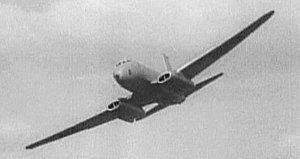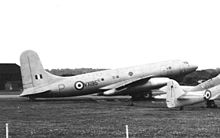Avro Ashton
| Avro Ashton | |
|---|---|
 Avro Ashton |
|
| Type: | Transport aircraft , experimental aircraft |
| Design country: | |
| Manufacturer: | |
| First flight: |
September 1, 1950 |
| Production time: |
1950-1952 |
| Number of pieces: |
6th |
The Avro 706 Ashton was one of the first jet-powered transport aircraft , of which only six prototypes were made by Avro in Great Britain in the early 1950s . As early as the 1940s it was known that jet aircraft could be used most efficiently above the tropopause , i.e. at altitudes above 12,000 m. In order to enable the passengers to travel safely and comfortably at this altitude, a complex system of pressure ventilation and air conditioning had to be created for the corresponding aircraft . The Avro Ashton was used by British research institutes mainly for test flights at high altitudes to develop appropriate facilities.
history
development
The origins of the Avro Ashton go back to a conversion of the second prototype of the Tudor 1 , which was subsequently referred to as the Tudor 8. The Tudor 8 essentially used the airframe of a Tudor 4, but received four Rolls-Royce Nene 5 turbojet engines installed in pairs in nacelles with a total static thrust of 22.3 kN (5000 lb). This first British aircraft with four jet engines flew for the first time on September 6, 1948 and was then mainly used as an altitude research aircraft.

As a result of the experience that Avro was able to gain with the Tudor 8, the development of a jet transport aircraft based on it with a tricycle landing gear began. The name of this design, which was ultimately not implemented, was Avro Type 705 Tudor 9 . The Tudor 9 formed the basis for a new high-altitude research aircraft that was to use the same Nene engines and was named Avro 706 Ashton . The Ministry of Supply commissioned the construction of six machines, in which existing cells of the Tudor 2 were used, with the hull being given thicker planking. While the Tudor 8 still used a tail wheel landing gear , all Ashtons got a nose wheel landing gear . The vertical stabilizer was also more rectangular than the round version of the Tudor 8.
Use and whereabouts
WB490
The WB490 used the airframe of the Tudor 2 with the registration G-AJJV or the RAF serial number TS896 and was the only Ashton Mk. 1. It flew for the first time on September 1, 1950. The first public screening was at the Farnborough SBAC Show a few days later . After the manufacturer's tests , the machine was transferred to the A & AEE in Boscombe Down in October 1951 , where it was used for altitude tests with the jet engines. In 1955 she received long-range tanks under the outer wing sections and a special autopilot. In 1956 she still flew, was then scrapped in Woodford in early 1957 and the fuselage was then used for further pressure tests.
WB491
The WB491 (Tudor-2 cell G-AJJW / TS897) was the only Ashton Mk. 2 and flew for the first time on August 2, 1951. The public presentation was at the 1951 Farnborough SBAC Show. It was then transferred to the RAE in Hampshire, where it was used for three years for experiments with the pressurized cabin (pressure maintenance, cooling, humidification and temperature control). At D. Napier in Luton, it was converted into a flying test bench for the National Gas Turbine Establishment , with a Rolls-Royce Avon first being carried in a gondola under the fuselage. In January 1955, this engine was successively replaced by a Rolls-Royce Conway Mk. 505 and later Mk. 508 (RA.28) with a device for examining icing processes, which was intended for the Boeing 707-420 . In 1956, an Armstrong Siddeley Sapphire was tested on the machine, with the icing device continued to be used. The test flights ended in 1960 and the machine was scrapped in April 1962. The fuselage has been preserved in the Newark Air Museum .
WB492
The first of three Ashton Mk.3 (Tudor-2 cell G-AJJX / TS898) flew for the first time on 6 July 1951 and was the Radar Research Establishment in Defford handed over for research purposes in the field of radar-controlled bombing. For this purpose, the machine received a bomb container over five meters long under the wings and a Mark IX H2S radar target for bombing in a lower hull radome . The tests were intended to serve as a suitability test for the NBS (Navigation Bombing System), which was to be used in the later V-bombers .
WB493
The second of three Ashton Mk. 3 (Tudor 2-cell G-AJJY / TS899) had its maiden flight on December 18, 1951 and was then transferred to the RAE in Farnborough for experiments on electrical on-board systems at high altitudes and for on-board instrument development to serve. In 1955, the Bristol Engine Division in Filton used the aircraft as a test bench for Bristol Olympus afterburner versions. One Olympus, one equipped with an afterburner, was installed outboard of the Nene gondolas. After the Olympus trials were completed, the left Olympus was replaced by a Bristol Orpheus (BOr.3) engine in 1956 . The experimental use of the WB493 ended in 1962.
WB994
The only Ashton Mk. 4 first flew on November 18, 1952. In 1954 she received a lower hull gondola for a bombardier and bomb container for research on the purely visually controlled bomb drop at the RAE Farnborough. From April 1958 to February 1959, de-icing tests were carried out with a Sapphire engine.
WE670
The third Aston Mk. 3 (Tudor 2-cell G-AJKA / TS901) flew for the first time on April 9, 1952 and was used by RAE Orfordness for ballistic bomb tests until July 1953. Napier then modified the machine in 1955, adding an Avon engine (RA.14) including a water spray device under the fuselage for attempts to freeze the air intake.
The crew for the test flights usually consisted of a pilot, copilot, navigator, flight engineer and radio operator; further scientific personnel could be accommodated in the spacious hull if this was necessary. The Mk. 1 and Mk. 2 still had the original pressurized cabin of the Tudor 2, but the pressurized area of the remaining Ashton designs was shortened.
Avro Ashton in the feature film
The Avro Ashton WB493, equipped with its two additional Olympus engines, portrayed the Phoenix of the fictional airline Atlas Aviation in the 1960 film Cone of Silence . The film is based on the 1959 novel by David Beaty, a former BOAC pilot. The plot dealt among other things with the starting problems of the Phoenix and the subsequent investigation of accidents. The story was based on the two real start-up accidents of the De Havilland DH.106 Comet .
Technical specifications
| Parameter | Data |
|---|---|
| crew | 5 |
| length | 89 ft 6.5 in (27.29 m) |
| span | 120 ft 0 in (36.58 m) |
| height | 31 ft 3 in (9.53 m) |
| Wing area | 1,421 ft² (132 m²) |
| Wing extension | 10.1 |
| Max. Takeoff mass | 82,000 lb (37,195 kg) |
| Top speed | 439 mph (707 km / h) |
| Service ceiling | 40,500 ft (approx.12,340 m) |
| Rate of climb | 2,900 ft / min (884 m / min) |
| Range | 1,725 miles (2,776 km) |
| Engines | 4 × Rolls-Royce Nene 6 Turbojet, 5,000 lbf (22 kN) |
See also
literature
- Brian Turpin: The Tudor Family - Part 2 . In: Airplane Monthly July 1977, pp. 340-347
- Barry Jones: Avro's Flying Lab - British post-war experimental jets, Part 21 . In: Airplane Monthly September 1995, pp. 34-42
- Martyn Chorlton: Avro Ashton - Database . In: Airplane Monthly October 2013, pp. 69–82
- AJ Jackson: Avro Aircraft since 1908 . London: Putnam Aeronautical Books, 2000 (revised edition), ISBN 0-85177-797-X , pp. 435-438
- John WR Taylor: Jane's Pocket Book of Research and Experimental Aircraft , London: Macdonald and Jane's Publishers Ltd, 1976, ISBN 0-356-08409-4 .



